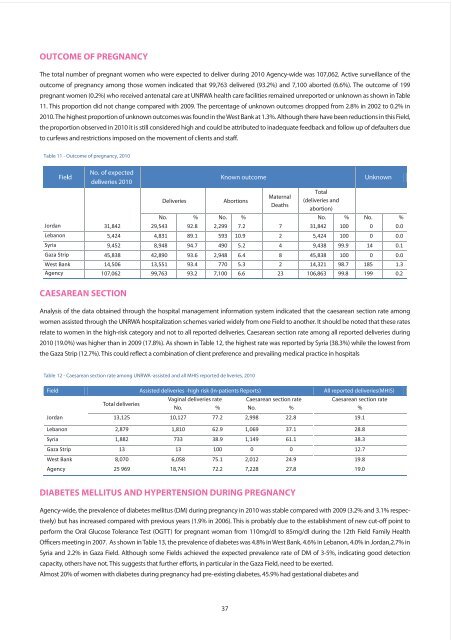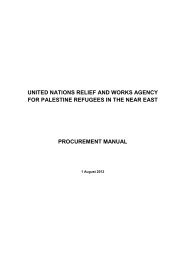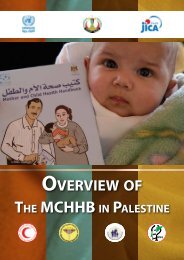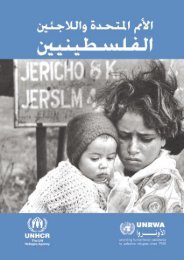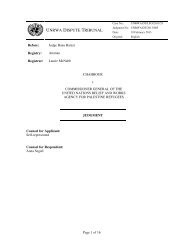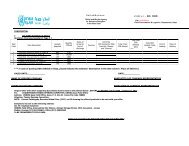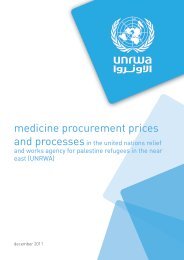Annual Report of the Department of Health 2010 - Unrwa
Annual Report of the Department of Health 2010 - Unrwa
Annual Report of the Department of Health 2010 - Unrwa
You also want an ePaper? Increase the reach of your titles
YUMPU automatically turns print PDFs into web optimized ePapers that Google loves.
OUTCOME OF PREGNANCY<br />
The total number <strong>of</strong> pregnant women who were expected to deliver during <strong>2010</strong> Agency-wide was 107,062. Active surveillance <strong>of</strong> <strong>the</strong><br />
outcome <strong>of</strong> pregnancy among those women indicated that 99,763 delivered (93.2%) and 7,100 aborted (6.6%). The outcome <strong>of</strong> 199<br />
pregnant women (0.2%) who received antenatal care at UNRWA health care facilities remained unreported or unknown as shown in Table<br />
11. This proportion did not change compared with 2009. The percentage <strong>of</strong> unknown outcomes dropped from 2.8% in 2002 to 0.2% in<br />
<strong>2010</strong>. The highest proportion <strong>of</strong> unknown outcomes was found in <strong>the</strong> West Bank at 1.3%. Although <strong>the</strong>re have been reductions in this Field,<br />
<strong>the</strong> proportion observed in <strong>2010</strong> it is still considered high and could be attributed to inadequate feedback and follow up <strong>of</strong> defaulters due<br />
to curfews and restrictions imposed on <strong>the</strong> movement <strong>of</strong> clients and staff.<br />
CAESAREAN SECTION<br />
Analysis <strong>of</strong> <strong>the</strong> data obtained through <strong>the</strong> hospital management information system indicated that <strong>the</strong> caesarean section rate among<br />
women assisted through <strong>the</strong> UNRWA hospitalization schemes varied widely from one Field to ano<strong>the</strong>r. It should be noted that <strong>the</strong>se rates<br />
relate to women in <strong>the</strong> high-risk category and not to all reported deliveries. Caesarean section rate among all reported deliveries during<br />
<strong>2010</strong> (19.0%) was higher than in 2009 (17.8%). As shown in Table 12, <strong>the</strong> highest rate was reported by Syria (38.3%) while <strong>the</strong> lowest from<br />
<strong>the</strong> Gaza Strip (12.7%). This could reflect a combination <strong>of</strong> client preference and prevailing medical practice in hospitals<br />
Table 12 - Caesarean section rate among UNRWA -assisted and all MHIS reported de liveries, <strong>2010</strong><br />
Field Assisted deliveries -high risk (In-patients <strong>Report</strong>s) All reported deliveries(MHIS)<br />
Total deliveries<br />
Vaginal deliveries rate Caesarean section rate Caesarean section rate<br />
No.<br />
%<br />
No.<br />
%<br />
%<br />
Jordan 13,125 10,127 77.2 2,998 22.8 19.1<br />
Lebanon 2,879 1,810 62.9 1,069 37.1 28.8<br />
Syria 1,882 733 38.9 1,149 61.1 38.3<br />
Gaza Strip<br />
13<br />
13<br />
100<br />
0<br />
0<br />
12.7<br />
West Bank 8,070 6,058 75.1 2,012 24.9 19.8<br />
Agency 25 969 18,741 72.2 7,228 27.8 19.0<br />
DIABETES MELLITUS AND HYPERTENSION DURING PREGNANCY<br />
Agency-wide, <strong>the</strong> prevalence <strong>of</strong> diabetes mellitus (DM) during pregnancy in <strong>2010</strong> was stable compared with 2009 (3.2% and 3.1% respectively)<br />
but has increased compared with previous years (1.9% in 2006). This is probably due to <strong>the</strong> establishment <strong>of</strong> new cut-<strong>of</strong>f point to<br />
perform <strong>the</strong> Oral Glucose Tolerance Test (OGTT) for pregnant woman from 110mg/dl to 85mg/dl during <strong>the</strong> 12th Field Family <strong>Health</strong><br />
Officers meeting in 2007. As shown in Table 13, <strong>the</strong> prevalence <strong>of</strong> diabetes was 4.8% in West Bank, 4.6% in Lebanon, 4.0% in Jordan,2.7% in<br />
Syria and 2.2% in Gaza Field. Although some Fields achieved <strong>the</strong> expected prevalence rate <strong>of</strong> DM <strong>of</strong> 3-5%, indicating good detection<br />
capacity, o<strong>the</strong>rs have not. This suggests that fur<strong>the</strong>r efforts, in particular in <strong>the</strong> Gaza Field, need to be exerted.<br />
Almost 20% <strong>of</strong> women with diabetes during pregnancy had pre-existing diabetes, 45.9% had gestational diabetes and<br />
37


